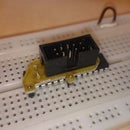Introduction: Prioritize/Sequential Li-Ion Battery Charger With TP4056
This small hack of TP4056 allows to prioritise one Li-Ion battery charging at a time, the goal is allowing the full power input to one cell at a time.
This hack is useful in my configuration setup, I use a single 10W solar panel to charge my 18650 cells, The panel gives 1.2 A 5V in sunny day and around 500mA +-5V during cloudy weather, The TP4056 is limited to 1A.
Supplies
- 2x TP4056
- 1x 2N222
- 1x 82 kΩ
- 1x 1.6 mΩ
Step 1: Hack TP4056
TP4056 characteristics:
- GPIOs drive the charging (!CHRG) and standby (!STDBY) LEDs are open drain output, it means that the GPIOs are pulled Low in order to turn ON a LED otherwise is set to high impedence to turn OFF a LED.
- The CE pin for Chip Enable Input allows to set the device in disabled mode or in normal operating mode depending of the applied voltage.
Bad idea: The initial idea was to use the associated charging (!CHRG) GPIOs to a pull up resistor to direct drive the CE pin on the second module. It was not a good idea because the charging (!CHRG) GPIOs slightly blink when any cells are connected causing ON/OFF in the second module.
What works: Then, the good idea is to use the standby (!STDBY)GPIOs which is a stable status when any battery is charging or when the battery is identified as fully charged.
Step 2: Desoldering and Wiring Module 2 (Lowest Priority)
Few soldering skills are required here, The CE pin (Chip Enable Input) of the second module must be desoldered and lifted up.
Step 3: Wiring Module 1 (highest Priority)
To solder a wire in standby (!STDBY) on the first module.
Step 4: Final Result
The module 1 (highest priority) is at right on the video.
The video shows:
- The charging of the cell 1 in the module 1
- The ending of cell's 1 charge and the auto activation of the module 2 (which is switching to charing mode)
- The Replacement of the cell on module 1 by a discharged cell and the auto deactivation of the module 2
Step 5: Conclusion
The hack
I tested the hack multiple days and it doesn't seem like having any side effect during replacement of a cell or when the power is unplugged and plugged in again.
Current drawn by the extra components:
5 V - 0.7V (transistor diode) = 4.3V
4.3 V : 82 kΩ = 0.000052 A ( 52 µA)
Limitation
There are no limitation by adding n modules in series, the standby (!STDBY)GPIOs is set to high impedance when the CE pin (Chip Enable Input) is in disable mode which is the voltage level to disable the next module (cascading disable voltage)













